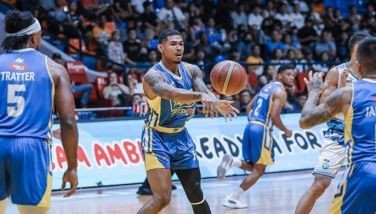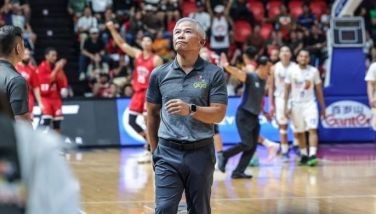Length is wealth

A PBA player with a generous wingspan has a big edge. Long arms give a cager the extra ability or inches to block shots, stretch in grabbing a rebound or loose ball, deflect passes and extend for a jumpshot beyond a defender’s reach. It goes without saying that length won’t mean much if a player doesn’t have the reflexes, intelligence or instincts to turn his physical attribute into an advantage. Basketball IQ is just as important.
Any player with at least an 80-inch wingspan is considered to be “lengthy.” Alaska’s Sam Eman boasts an 86 1/2-inch reach while teammate Sonny Thoss checks in at 82. Another Alaska frontliner Mike Burtscher and Barako Energy Coffee’s Bryan Faundo are listed at 81. Measuring 80 inches are B-Meg’s Niño Canaleta and Marc Pingris, San Miguel Beer’s Arwind Santos, Alaska’s Erwin Sotto and Rain Or Shine’s Paolo Bugia. For comparison purposes, Manny Pacquiao’s wingspan is 67 inches compared to Antonio Margarito’s 73.
It’s possible that a short-armed athlete may be measured to have a long wingspan because he has a wide back. The key to enjoying a wingspan advantage is to have long arms so that an athlete with an extended reach because of a wide back isn’t necessarily gifted in this department.
Measuring wingspan involves extending both arms sideways and sizing from the tip of the middle finger of one hand to the other, meaning from end to end, including the width of one’s back.
In the recent PBA draft, only three players were taped with at least an 80-inch reach – 6-3 Elmer Espiritu at 82 1/2, 6-7 Rabeh Al-Hussaini at 82 and 6-4 Ford Arao at 80. All three were picked in the draft. Those with less than a 70-inch wingspan were 5-5 1/2 Dennis Rodriguez and 5-6 Ramon Regata at 66, 5-8 1/4 Rudy Lingganay at 67 1/2 and 5-7 Jai Reyes at 69. Of the four short-armed cagers, only Reyes was drafted – by Powerade with the No. 18 ticket traded by Air 21.
* * * *
London-based Cebu sportswriter Jack Biantan sent in a commentary about the state of Philippine football today.
“What has the Philippine Football Federation (PFF) done for football?” sighed Biantan. “Referees seminars? Coaches seminars? But where are the tournaments? What will the coaches and referees do without tournaments? What has the PFF done to the money left behind by the previous administration? And the millions that Sepp Blatter of FIFA gifted to all developing member countries? The PFF is one of the richest sports associations in the Philippines. Just go to their headquarters and you will see how rich they are. Just check where the president has traveled these past two years – first class – and you will be scandalized by his extravagance.
“Last year, the PFF asked Cebu to spearhead its Vision Asia football development program. The Asian Football Confederation (AFC) allocated millions for this. The Cebu Football Association (CFA) jumped on the project and picked coaches who were supposed to be paid by Vision Asia money. Days passed, then weeks, then months. But where was the money for the coaches?
“When CFA president Richard Montayne went to Manila to look for the money, he did not get any answer except for an e-mail from the PFF president chiding him for writing the AFC about the funds. Eventually, the project ground to a halt. Pocketing the coaches’ stipends is beyond my imagination. It is the lowest of the low. I thought the PFF had a Board of Trustees made up of good men. I am convinced that Philippine football is facing one of its darkest hours.
* * * *
In basketball, you normally shoot a higher percentage from the free throw line than from the floor. That’s because you’re not defended at the stripe.
Of the 163 cagers (excluding imports) who saw action in the PBA this past season, only 14 hit at a loftier clip from the field than the line – less than 10 percent of the playing population, meaning they’re in a lowly minority.
The 14 were J. R. Quinahan (.472 FG%, .429FT%), Gilbert Lao (.346, .313), Dorian Peña (.505, .441), Rafi Reavis (.529, .488), Sam Eman (.508, .500), Mike Burtscher (.313, .167), Francis Allera (.354, .200), Marlou Aquino (.467, .429), Richard Yee (.549, .533), Billy Mamaril (.479, .471), Bruce Viray (.500, .000/0-2 FTs), Adonis Sta. Maria (.273, .143), Bryan Faundo (.373, .250) and Charles Waters (.500, .250).
Allera’s remarkable (though dubious) feat was hitting at a higher clip from three-point distance (.385 on 10-of-26 triples) than the stripe (1-5 or .200).
There were 31 players who attempted at least once from three-point range and never found the mark. Aaron Aban topped the list of misguided riflemen with 0-of-14. Others in the honor roll were Cesar Catli at 0-of-11, Asi Taulava and Rudy Hatfield both at 0-of-7, Allan Salangsang at 0-of-4 and Chris Calaguio, Viray and Chito Jaime at 0-of-3.
- Latest
- Trending






























